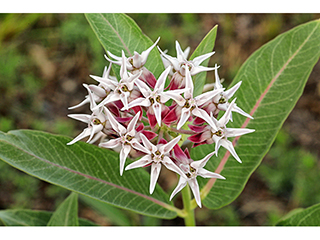
Monarch caterpillar host plant.
This perennial has large, oval, blue-green leaves and spherical clusters of rose-colored flowers. The flowers occur at the top of the stem and on stalks from leaf axils and bloom May to September.
Growing Conditions: Shade intolerant, needs sunlight, medium water use, moist soil
Plant Size: Generally 1 ½ – 3 ft (46 – 91 cm) but can reach 6 ft (183 cm) under favorable conditions
This species is closely related to the Common milkweed, A. syriaca, with which it sometimes hybridizes at the eastern limits of its distribution. These species are similar in appearance and growth form (tall and robust), but can be distinguished by the layer of fine white hairs on A. speciosa and flowers that look like small crowns. Unlike A. syriaca, A. speciosa does not form large clones.
More from USDA Plants Database »